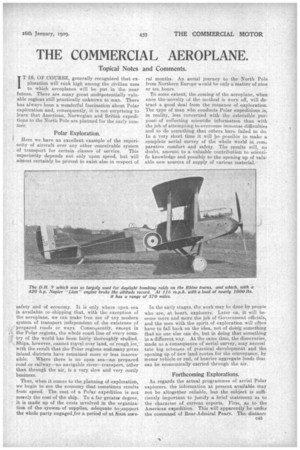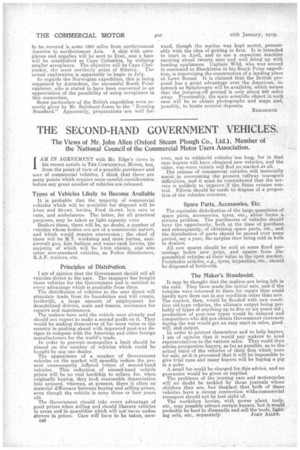THE COMMERCIAL AEROPLANE.
Page 19

Page 20

If you've noticed an error in this article please click here to report it so we can fix it.
Topical Notes and Comments.
IT IS, OF COURSE, generally recognized that exploration will rank high among the civilian uses to which aeroplanes will be put in the near future. There are many great anclApotentiaIly valuable regions still practically unknown to man. There has always been a wonderful fa,scination about Polar exploration and, consequently, it is not surprising to learn that American, Norwegian and British expeditions to the North Pole are planned for the early summer.
Polar Exploration.
Here we have an excellent example of the superiority of aircraft over any other conceivable system of transport for certain classes of service. This superiority depends not only upon speed, but will almost certainly be proved to exist also in respect of safety and of economy. It is only where open sea is available to shipping that, with the exception of the aeroplane, we can make free use of any modern system of transport independent of the existence of prepared roads or ways. Consequently, except in .. the Polar regions, the whole coast line of every country of the world has been fairly thoroughly studied. Ships, however, cannot travel over land, or-rough ice, 'with the result that the Polar regions andsmany great inland districts have remained more or less inaccessible. Where there is no open sea—no prepared road or railway—no navigable river—transport, other than through the air, is a very slow and very costly business.
Thus, when it comes to the.planning of exploration, we begin to see the economy that sometimes results from speed. The cost of a Polar expedition is not merely the cost of the ship. To a far greater degree, it is made up of the costs involved in the organization of the system, of supplies, adequate talaupport the whole party ezigaged,for a period of at liast sere rat months. An aerial journey to the North Pole from Northern Europe would be only a matter of nine or ten hours.
To some extent, the coming of the aeroplane, when once the.novelty of the method is worn off, will detract a good deal from the romance of exploration. The type of man who conducts Polar expeditions is, in reality, less concerned with the ostensible purpose of collecting scientific information than with the job of attempting to overcome immense difficulties and to do something that others have failed to do. In a, very short time it will he possible to make a complete aerial survey of the whole world in corn, parative comfort and safety. The results will, no doubt, amount to a valuable contribution to scientific knowledge and possibly to the opening up of valuable new sources of supply of various material.
In the early stages. the work may be done by peOple who 'are, at heart, explorers. Later on, it will become more and more the job of Government officials and the men with the spirit of exploration will often have to fall back on the idea, not of doing something that no one else can do, but in doing that something in a different way. At the same time, the discoveries, made as a. consequence of aerial survey, may necessi tate big schemes of piactical development and the opening up of new land routes for the conveyance, by motor vehicle or rail, of heavier aggregate loads thar can be economically carried through the air.
Forthcoming Explorations.
:is regards the actual programmes of aerial Polar explorers, the information at present available may not be altogether reliable, but the subject is sufficiently important to 'justify a brief statement as to the character of current reports. First, as to the American expedition. This will apparently be under the command of Rear-Admiral rearv. The distance to be covered is some 1300 miles from northernmost America to northernmost Asia. A ship with aeroplanes and supplies will be sent to Etah, and a base will be established at Cape Columbia, by utilizing smaller aeroplanes. The objective will be Cape Chetyuskin, the most northerly point of Siberia.The actual exploration is apparently to begin in July.
As regards the Norwegian expedition, this is being organized by Amundsen, the successful South Polar explorer, who is stated to have been converted to an appreciation of the possibility of using aeroplanes in this connection.
Some particulars of the British expedition were recently given by Mr. Salisbury-Jones to the "Evening Standard." Apparently, preparations are well for
ward, though the matter was kept secret, presumably with the idea of getting in first. It is intended to start in April, and to use a capacious machine carrying about twenty men and well fitted up with heating appliances. Captain Wild, who was second in command to Shackleton in his South Polar expedition_, is supervising the construction of a landing 'place at Lowe Sound. It is claimed that the British proposal has a great advantage over the American, inasmuch as Spitzbergen will be available, which means that the jumping-off ground is only about 900 miles away. Presumably, the main scientific object in each ease will be to obtain photographs and maps and, possibly, to locate mineral deposits.
BEMERIDGE






















